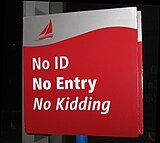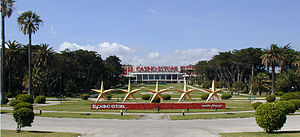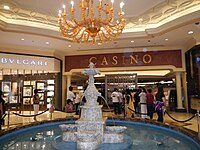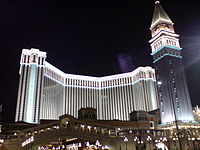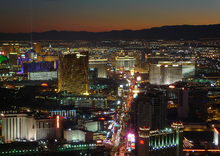
The
Las Vegas Strip is renowned for its high concentration of casino resort hotels
In modern English, a
casino is a facility which houses and accommodates certain types of
gambling activities. The industry that deals in casinos is called the
gaming industry. Casinos are most commonly built near or combined with hotels, restaurants, retail shopping, cruise ships or other tourist attractions. There is much debate over whether or not the social and economic consequences of casino gambling outweigh the initial revenue that may be generated.
[1] In the United States, some states that have high unemployment and budget deficits have turned to legalizing casinos, often in places that are not tourist destinations. Some casinos are also known for hosting live entertainment events, such as stand-up comedy, concerts, and sporting events.
Etymology and usage
The term "casino" is a confusing linguistic
false friend for translators.
Casino is of
Italian origin; the root
casa (house) originally meant a small country
villa,
summerhouse, or
pavilion.
[citation needed] During the 19th century, the term
casino came to include other public buildings where pleasurable activities took place; such edifices were usually built on the grounds of a larger Italian villa or
palazzo, and were used to host civic town functions, including dancing, gambling, music listening, and sports; examples in Italy include
Villa Farnese and
Villa Giulia, and in the US the
Newport Casino in
Newport, Rhode Island. In modern-day Italian, the term
casino designates a
bordello (also called
casa chiusa, literally "closed house"), while the gambling house is spelled
casinò with an accent.
[2]
In military and non-military usage in German and Spanish, a
casino or
kasino is an officers'
mess.
[citation needed] Curiously, in Italian—the source-language of the word—a
casino is either a brothel, a mess, or a noisy environment, while a gaming house is called a
casinò.
[citation needed]
History of gambling houses
The precise origin of gambling is unknown. It is generally believed that gambling in some form or another has been seen in almost every society in history. From the Ancient
Greeks and Romans to Napoleon's
France and Elizabethan
England, much of history is filled with stories of entertainment based on games of chance.
The first known European gambling house, not called a casino although meeting the modern definition, was the
Ridotto, established in
Venice, Italy in 1638 to provide controlled gambling during the carnival season. It was closed in 1770 as the city government perceived it to impoverish the local gentry.
In American history, early gambling establishments were known as
saloons. The creation and importance of saloons was greatly influenced by four major cities;
New Orleans,
St. Louis,
Chicago and
San Francisco. It was in the saloons that travelers could find people to talk to, drink with, and often gamble with. During the early 20th century in America, gambling became outlawed and banned by state legislation and social reformers of the time. However, in 1931, gambling was legalized throughout the state of
Nevada. America's first legalized casinos were set up in those places. In 1978
New Jersey allowed gambling in
Atlantic City, now America's second largest gambling city.
Gambling in casinos
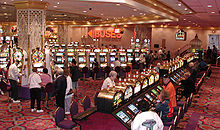
Slot machines in Atlantic City. Slot machines are a standard attraction of casinos
Most jurisdictions worldwide limit gambling to persons over the age of
license (16 to 21 years of age in most countries which permit the operation of casinos).
[5]
Customers gamble by playing
games of chance, in some cases with an element of skill, such as
craps,
roulette,
baccarat,
blackjack, and
video poker. Most games played have mathematically determined
odds that ensure the house has at all times an overall advantage over the players. This can be expressed more precisely by the notion of
expected value, which is uniformly negative (from the player's perspective). This advantage is called the
house edge. In games such as poker where players play against each other, the house takes a commission called the
rake. Casinos sometimes give out complimentary items or
comps to gamblers.
Payout is the percentage of funds ("winnings") returned by players.
Casinos in the USA say that a player staking money won from the casino is playing with the house's money.
Video Lottery Machines (slot machines) have become one of the most popular form of gambling in casinos. As of 2011 investigative reports have started calling into question whether the modern-day slot-machine is addictive.
[6]
Design
Casino design—regarded as a psychological exercise—is an intricate process that involves optimising floor plan, décor and atmospherics to encourage consumer gambling.
[7]
Factors influencing consumer gambling tendencies include sound, odour and lighting. Natasha Dow Schüll, an anthropologist at the Massachusetts Institute of Technology, highlights the audio directors at Silicon Gaming’s decision to make its slot machines resonate in, “the universally pleasant tone of C, sampling existing casino soundscapes to create a sound that would please but not clash”.
[8]
Dr Alan Hirsch, founder of the Smell & Taste Treatment and Research Foundation in Chicago, studied the impact of certain scents on gamblers, discerning that a pleasant albeit unidentifiable odour released by Las Vegas slots machines generated approximately 50% more in daily revenue. He suggested that the scent acted as an aphrodisiac, facilitating a more aggressive form of gambling.
[9]
Casino designer
Roger Thomas is credited with implementing a successful, disruptive design for the Las Vegas Wynn Resorts’ casinos in 2008. He broke casino design convention by introducing natural sunlight and flora to appeal to a female demographic. Thomas inserted skylights and antique clocks, defying the commonplace notion that a casino should be a timeless space.
[10]
Markets
The following lists major casino markets in the world with casino revenue of over $1 billion USD as published in
PricewaterhouseCoopers's report on the outlook for the global casino market:
[11]
By region[edit]
|
| 1 | United States | | 57,240 | 56,500 | 58,030 |
| 2 | Asia Pacific | | 21,845 | 32,305 | 41,259 |
| 3 | Europe, Middle East, Africa | | 17,259 | 16,186 | 16,452 |
| 4 | Canada | | 3,712 | 3,835 | 4,045 |
| 5 | Latin America | | 425 | 528 | 594 |
| | Total | | 100,481 | 109,354 | 120,380 |
By markets[edit]
|
| 1 | Macau | 33 | 14,955 | 22,445 | 28,379 |
| 2 | Las Vegas, Nevada | 122 | 10,247 | 9,950 | 10,300 |
| 3 | Singapore | 2 | 2,119 | 2,750 | 5,479 |
| 4 | France | 189 | 3,965 | 3,909 | 3,957 |
| 5 | Atlantic City, New Jersey | 12 | 3,943 | 3,550 | 3,330 |
| 6 | Australia | 11 | 2,697 | 2,769 | 2,847 |
| 7 | South Korea | 17[12] | 2,401 | 2,430 | 2,512 |
| 8 | Germany | 76 | 2,073 | 2,055 | 2,081 |
| 9 | South Africa | 36[13] | 1,845 | 1,782 | 2,012 |
| 10 | United Kingdom | 141 | 1,212 | 1,193 | 1,209 |
| 11 | Poland | 36[14] | 1,089 | 1,091 | 1,126 |
| 12 | Niagara Falls, Canada | 2 | 1,102 | 1,114 | 1,203 |
By company[edit]
According to Bloomberg, accumulated revenue of biggest casino operator companies worldwide amounted almost 55 billion US dollars as per 2011. SJM Holdings ltd. was the leading company in this field and earned 9.7 billion in 2011, followed by Las Vegas Sands Corp. (7.4 bn). The third biggest casino operator company (based on revenue) was Caesars Entertainment with revenue of 6.2 bn US dollar.
[15]
Significant sites[edit]
While there are casinos in many places, a few places have become well-known specifically for gambling. Perhaps the place almost defined by its casino is Monte Carlo, but other places are known as gambling centers.
MONTE CARLO, MONACO[EDIT]
Monte Carlo has a famous casino popular with well-off visitors and is a tourist attraction in its own right. A
song and a
film named
The Man Who Broke the Bank at Monte Carlo need no explanation—they clearly refer to the casino.
The casino has made Monte Carlo so well known for games of chance that mathematical methods for solving various problems using many
quasi-random numbers—numbers with the statistical distribution of numbers generated by chance—are formally known as
Monte Carlo methods. Monte Carlo was part of the plot in a few
James Bond novels and films.
SINGAPORE[EDIT]
UNITED STATES[EDIT]
With currently over 900 casinos, the United States has the largest number of casinos in the world. The number continues to steadily grow as more states seek to legalize casinos. 38 states now have some form of casino gambling. Relatively small places such as Las Vegas are best known for gambling; larger cities such as
Chicago are not defined by their casinos in spite of the large turnover.
Top American casino markets by revenue (2009 annual revenues):
[18]
- Las Vegas Strip $5.550 billion
- Atlantic City $3.943 billion
- Chicago region $2.092 billion
- Connecticut $1.448 billion
- Detroit $1.36 billion
- St. Louis $1.050 billion
- Tunica Resorts, Mississippi $997.02 million
- Biloxi, Miss. $833.50 million
- Shreveport, Louisiana $779.65 million
- Boulder Strip (Las Vegas) $774.33 million
- Reno, Nevada $715.23 million
- New Orleans, Louisiana $653.05 million
- Downtown Las Vegas $523.82 million
- Laughlin, Nevada $492.51 million
Indian gaming has been responsible for a rise in the number of casinos outside of Las Vegas and Atlantic City.
Security[edit]
Given the large amounts of currency handled within a casino, both patrons and staff may be tempted to cheat and steal, in collusion or independently; most casinos have security measures to prevent this.
Security cameras located throughout the casino are the most basic measure.
Modern casino security is usually divided between a physical security force and a specialized surveillance department. The physical security force usually patrols the casino and responds to calls for assistance and reports of suspicious or definite criminal activity. A specialized surveillance department operates the casino's
closed circuit television system, known in the industry as the
eye in the sky. Both of these specialized casino security departments work very closely with each other to ensure the safety of both guests and the casino's assets, and have been quite successful in preventing crime.
[19] Some casinos also have catwalks in the ceiling above the casino floor, which allow surveillance personnel to look directly down, through one way glass, on the activities at the tables and slot machines.
When it opened in 1989,
The Mirage was the first casino to use cameras full-time on all table games.
[20]
In addition to cameras and other technological measures, casinos also enforce security through rules of conduct and behavior; for example, players at card games are required to keep the cards they are holding in their hands visible at all times.
Business practices[edit]
Over the past few decades, casinos have developed many different marketing techniques for attracting and maintaining loyal patrons. Many casinos use a loyalty rewards program used to track players' spending habits and target their patrons more effectively, by sending mailings with free slot play and other promotions.
[21]
One area of controversy surrounding casinos is their relationship to crime rates. Economic studies that show a positive relationship between casinos and crime usually fail to consider the visiting population at risk when they calculate the crime rate in casino areas. Such studies thus count the crimes committed by visitors, but do not count visitors in the population measure, and this overstates the crime rates in casino areas. Part of the reason this methodology is used, despite it leading to an overstatement of crime rates is that reliable data on tourist count are often not available.
[22] In a 2004 report by the US Department of Justice, researchers interviewed people who had been arrested in Las Vegas and Des Moines and found that the percentage of problem or pathological gamblers among the arrestees was three to five times higher than in the general population.
[23] According to some police reports, incidences of reported crime often double and triple in communities within three years of a casino opening.
[24]
Gallery[edit]

 1 Comment
1 Comment

 The iPhone 6s' sale date has been given away in a
The iPhone 6s' sale date has been given away in a 













